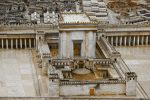
Bet HaMikdash as a Singularity in Space-time
Introduction In this essay, I intend to draw a parallel between the singularity in space-time, such as the putative point of origin of the universe

Introduction In this essay, I intend to draw a parallel between the singularity in space-time, such as the putative point of origin of the universe

The Temple Menorah served as a lighthouse, illuminating darkness and providing purpose and direction.

And on the eighth day, the flesh of his foreskin shall be circumcised. Leviticus 12:3 In the Torah portion of Tazria, we are commanded to

And for the unclean they shall take of the ashes of the burning of the purification from sin, and running water shall be put thereto
Structurally identical biblical accounts of creation, destruction, and restoration are viewed as a manifestation of dialectic triad thesis-antithesis-synthesis.

The history of Creation can be expressed in three words (not even words but mere conjunctions): “and,” “or,” and “and/or,” whereas the history of physics

Introduction Today, on Tisha B’Av—the ninth day of Av, this year commemorated on the tenth day of Av because the ninth is Shabbat, when mourning

A light shalt thou make to the ark, and to a cubit shalt thou finish it upward; and the door of the ark shalt thou

The months of Tishrei is full of holidays, and they all share a common theme—the unification of time—past, present, and future. It all starts with

Yesterday was the 9th day of the month of Av or, in Hebrew, Tisha B’Av. Usually, Tisha B’Av is marked by mourning and fasting. Yesterday,

Continuing the theme of my last post, Mishkan – a Metaphor for Quantum Reality, the analogy between the Tabernacle (“Mishkan”) and quantum reality goes even

And thou shalt make two cherubim of gold; of beaten work shalt thou make them, at the two ends of the ark-cover. And make one

As I wrote in my post, Schrödinger Menorah: Burning And Not Burning, the Lubavitcher Rebbe, Rabbi Menachem Mendel Schneerson, explains the miracle of Chanukah as

The miracle of Chanukah revolves around a single-day-supply of olive oil burning for eight days during the rededication of the Holy Temple in Jerusalem (Bet
When G‑d created the first humans, Adam and Eve (Chavah), He created them as one. And G‑d created man in His own image, in the

These are the journeys of the children of Israel… (Numbers 33:1) When G-d brought the Jews out from Egypt, He brought them out with the mystery of

In quantum mechanics, the state of a physical system is described by the so-called wave function (or the “wavefunction”). All attempts by Schrödinger, who first
And let them make me a Sanctuary that I may dwell among them (Ex. 25:8) In modern physics, there are two paradigms usually expressed as locality

Some people may be fooled by randomness but, when we realize that randomness opens the door to the Divine, we are saved by randomness. It

The Hebrew words taharah and tumah, which are the subjects of the Torah portion of Chukat (Numbers 19:1–22:1), are usually translated as ritual purity and